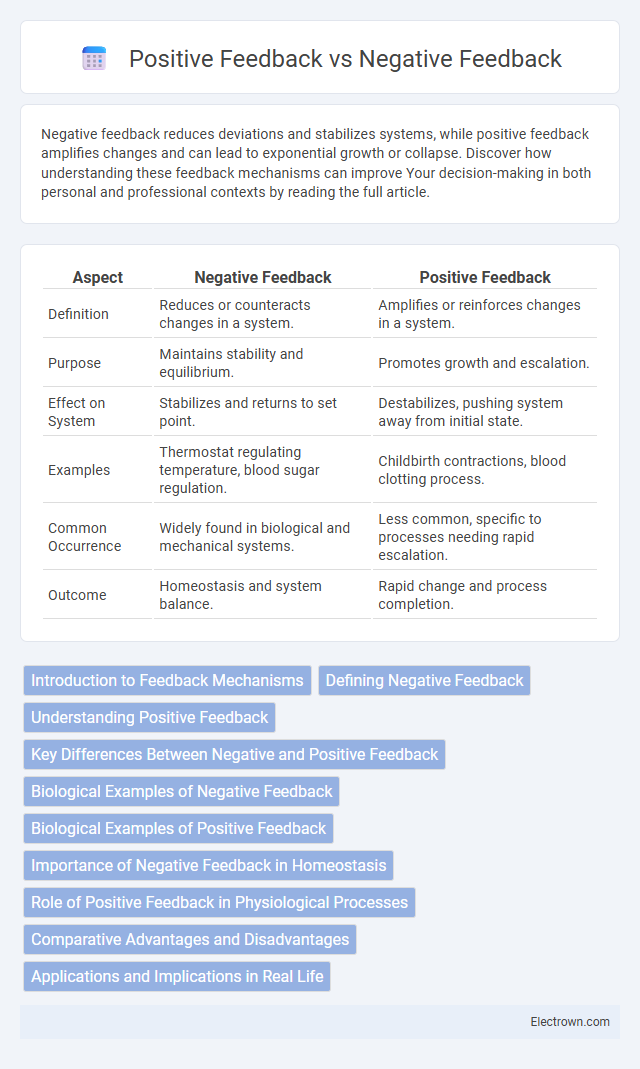Negative feedback reduces deviations and stabilizes systems, while positive feedback amplifies changes and can lead to exponential growth or collapse. Discover how understanding these feedback mechanisms can improve Your decision-making in both personal and professional contexts by reading the full article.
Table of Comparison
| Aspect | Negative Feedback | Positive Feedback |
|---|---|---|
| Definition | Reduces or counteracts changes in a system. | Amplifies or reinforces changes in a system. |
| Purpose | Maintains stability and equilibrium. | Promotes growth and escalation. |
| Effect on System | Stabilizes and returns to set point. | Destabilizes, pushing system away from initial state. |
| Examples | Thermostat regulating temperature, blood sugar regulation. | Childbirth contractions, blood clotting process. |
| Common Occurrence | Widely found in biological and mechanical systems. | Less common, specific to processes needing rapid escalation. |
| Outcome | Homeostasis and system balance. | Rapid change and process completion. |
Introduction to Feedback Mechanisms
Feedback mechanisms regulate biological systems by maintaining stability or amplifying processes through negative and positive feedback loops. Negative feedback reduces deviations from a set point, promoting homeostasis in systems like body temperature and blood glucose levels. Positive feedback amplifies responses, driving processes such as blood clotting and childbirth contractions to completion.
Defining Negative Feedback
Negative feedback is a regulatory mechanism in biological and electronic systems where an output reduces the initial stimulus, maintaining stability and equilibrium. In physiological processes, negative feedback loops control variables such as body temperature and blood glucose levels by counteracting deviations from set points. This feedback type enhances system resilience by preventing excessive fluctuations and promoting homeostasis.
Understanding Positive Feedback
Positive feedback amplifies changes by reinforcing the direction of a stimulus, often leading to exponential growth or rapid system shifts. This mechanism is crucial in processes like blood clotting, childbirth contractions, and nerve signal transmission. Unlike negative feedback, which stabilizes systems by counteracting deviations, positive feedback propels systems toward a new state or outcome.
Key Differences Between Negative and Positive Feedback
Negative feedback counteracts changes in a system, promoting stability by reducing deviations from a setpoint, while positive feedback amplifies changes, driving a system toward a new state or extreme. Negative feedback loops are common in homeostasis, such as body temperature regulation, whereas positive feedback occurs in processes like blood clotting and childbirth. The fundamental difference lies in their effects on system dynamics: negative feedback maintains equilibrium, and positive feedback accelerates change.
Biological Examples of Negative Feedback
Biological examples of negative feedback include the regulation of blood glucose levels by insulin and glucagon, where insulin lowers high blood sugar and glucagon raises low levels, maintaining homeostasis. Another example is body temperature control through sweating and shivering, which helps your body return to its optimal temperature. These mechanisms are essential for stabilizing internal conditions and ensuring proper physiological function.
Biological Examples of Positive Feedback
Positive feedback in biological systems amplifies physiological processes to achieve specific outcomes, such as the release of oxytocin during childbirth, which intensifies uterine contractions until delivery. Another example includes blood clotting, where initial platelet aggregation triggers more platelets to accumulate at the injury site, accelerating clot formation. Understanding these mechanisms helps you appreciate how positive feedback loops drive vital, self-reinforcing responses in living organisms.
Importance of Negative Feedback in Homeostasis
Negative feedback plays a crucial role in maintaining homeostasis by counteracting deviations from set points, ensuring the stability of internal conditions such as temperature, blood pressure, and glucose levels. This mechanism detects changes and initiates responses to reverse the effect, preventing harmful fluctuations within the body. Your body relies on negative feedback loops to preserve equilibrium and support overall health.
Role of Positive Feedback in Physiological Processes
Positive feedback amplifies physiological responses, playing a crucial role in processes such as blood clotting and childbirth by intensifying the original stimulus to achieve a specific outcome quickly. This mechanism contrasts with negative feedback, which works to maintain homeostasis by counteracting deviations from a set point. Key examples include the release of oxytocin during labor, where positive feedback enhances uterine contractions until delivery occurs.
Comparative Advantages and Disadvantages
Negative feedback enhances system stability and accuracy by counteracting deviations, making it ideal for maintaining desired output levels, but it can reduce system responsiveness and amplify noise under certain conditions. Positive feedback accelerates system response and can induce bistability or oscillations, useful in applications like signal amplification or switching, yet it risks system instability and runaway effects without careful control. Balancing these feedback types involves trade-offs between stability, sensitivity, and speed in control system design.
Applications and Implications in Real Life
Negative feedback stabilizes systems by counteracting deviations, commonly used in thermostat temperature control and biological homeostasis to maintain balance. Positive feedback amplifies changes, seen in processes like blood clotting and childbirth contractions, facilitating rapid and decisive responses. Understanding these feedback mechanisms aids in designing efficient engineering systems, medical treatments, and ecological management strategies.
negative feedback vs positive feedback Infographic

 electrown.com
electrown.com